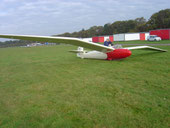Martin Schempp and Wolf Hirth

Martin Schempp (23 March 1905 - 9 July 1984) was a glider pilot and one of the founders of Shempp-Hirth, a major manufacturer of gliders and sailplanes.
Martin Schempp was born in Stuttgart. In 1926, at the age of 21, he emigrated to the USA in the hope of finding better working conditions there. A talk by Charles Lindberg about his Atlantic crossing so inspired Martin about aviation that he returned to Germany in 1928 to learn how to fly. Martin Schempp returned 1929 to the USA to build German sailplane designs under license there at "Haller-Hirth Sailplanes" and to act as a soaring instructor at "Haller School Of Soaring Flight" in Pittsburgh .He moved to California at the end of 1932, where he worked with Hawley Bowlus on his high-performance sailplane "Albatros".With the assistance of Wolf Hirth, Martin Schempp opened in Göppingen his own company in 1935: "Sportflugzeugbau Göppingen Martin Schempp". The Gö 1 "Wolf" and Gö 3 "Minimoa" became world-renowned sailplanes. In 1938, Wolf Hirth, mainly responsible for the design work, officially became a partner in the company, which then took on the new name “Sportflugzeugbau Schempp-Hirth”. The company relocated to Kirchheim-Teck the same year. By 1939, the list of customers included clients from all continents except Australia. The Minimoa, 110 of which were built, is still regarded as one of the most beautiful sailplanes from the wood era. In 1939, Wolf Hirth opened his own company in Nabern, which collaborated closely with Schempp-Hirth during the war. In addition to sailplanes for pilot training, the two companies supplied the two-seater Gö IV (designed by Wolfgang Hütter); the Habicht, an aerobatic glider, and wooden subassemblies for Messerschmitt, the Me-321/323 "Gigant" and the Me-109 fighter. When gliders were allowed to fly again in Germany in 1951, he ceded the sailplane market to Wolf Hirth. Martin Schempp acquired the license to build the best standard-class sailplane of its time, the "Standard Austria," and put it into mass production. Martin Schempp soon realized that the future would belong to composite sailplanes.
Martin Schempp died after a long illness on July 9, 1984.
Source: Wikipedia

Wolf Hirth at right
Wolfram Kurt Erhard Hirth (February 28, 1900 – July 25, 1959) was a German gliding pioneer and sailplane designer. He was a co-founder of Schempp-Hirth, still a renowned glider (sailplane) manufacturer.
As a young man, Hirth took up gliding and was soon drawn to the Wasserkuppe, then the focus of the German gliding movement, earning his pilot's licence in 1920. In 1924. In 1928, he graduated from the Technical University of Stuttgart with a diploma in engineering and began to focus on aircraft construction. On 10 March 1931 he gave a demonstration of glider aerobatics over New York City. On one of these publicity trips, he suffered major injuries in a crash in Hungary, requiring a hospital stay of four months.
Wolf Hirth also took part in International Championships of Touring Aircraft Challenge 1929, Challenge 1932 (6th place) and Challenge 1934 (13th place). After some time in the USA he returned to Germany in 1934 because of US economic depression. With the assistance of Wolf Hirth, Martin Schempp founded his own company in Göppingen in 1935: "Sportflugzeugbau Göppingen Martin Schempp". In 1938, Wolf Hirth, mainly responsible for the design work, officially became a partner in the company, which then took on the new name “Sportflugzeugbau Schempp-Hirth”. The company relocated to Kirchheim-Teck the same year. The company first manufactured a small training glider, the Göppingen Gö 1, intended to rival the Grunau Baby. The company's first real success, however, was the Gö 3 Minimoa, a distinctive aircraft with an elegant gull wing design that was used to break several world records and win championships around the world.
Hirth continued to direct the firm throughout World War II. In 1940 the company began manufacturing assembly parts for Messerschmitt Me 323 and Me 109 and other aircraft. From 1945 the company made furniture and other wooden components for industry until glider production could begin again in 1951. He was elected President of the German Aero-Club in 1956.
He had a heart attack while flying his Lo-150 aerobatic glider in 1959 and died in the subsequent crash.
 Göppingen Gö3
"Minimoa" PH-80
Göppingen Gö3
"Minimoa" PH-80

